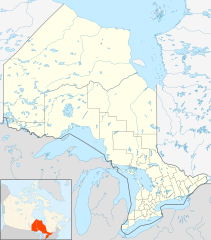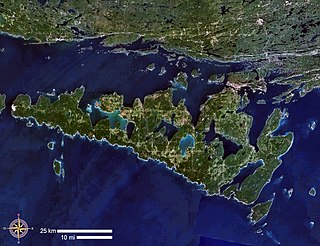
Manitoulin Island is an island in Lake Huron, located within the borders of the Canadian province of Ontario, in the bioregion known as Laurentia. With an area of 2,766 km2 (1,068 sq mi), it is the largest lake island in the world, large enough that it has over 100 lakes itself. In addition to the historic Anishinaabe and European settlement of the island, archaeological discoveries at Sheguiandah have demonstrated Paleo-Indian and Archaic cultures dating from 10,000 BC to 2,000 BC.
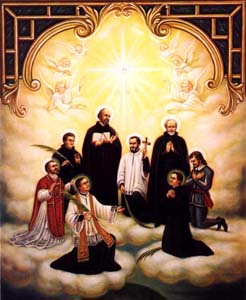
The Canadian Martyrs, also known as the North American Martyrs, were eight Jesuit missionaries from Sainte-Marie among the Hurons. They were ritually tortured and killed on various dates in the mid-17th century in Canada, in what is now southern Ontario, and in upstate New York, during the warfare between the Iroquioan tribes the Mohawk and the Huron. They have subsequently been canonized and venerated as martyrs by the Catholic Church.
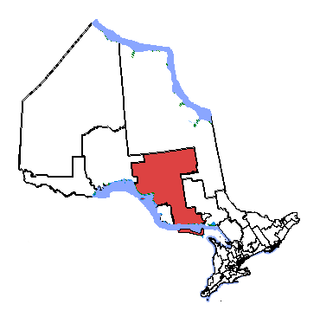
Algoma—Manitoulin—Kapuskasing is a federal electoral district in Ontario, Canada, that has been represented in the House of Commons of Canada since 2004. The area was represented by the riding of Algoma from 1867 to 1904 and from 1968 to 1996 and then by Algoma—Manitoulin from 1996 to 2004.

Gore Bay became a town on 7 April 1890, on Manitoulin Island in Ontario, Canada. Located on Gore Bay, a bay of Lake Huron's North Channel, it is one of the two incorporated towns of Manitoulin District, of which it is the administrative and government seat. After the Treaty of 1862, Manitoulin Island was open for white settlement. Small towns began to emerge from the wilderness, and hotels were developed to provide lodgings for prospective land purchasers. This led to the formation of the town Gore Bay. The town's name is believed to be referencing the gore-shaped harbour. Other theories for the namesake are probably for Francis Gore (1769–1852), Lieutenant-Governor of Upper Canada from 1806 to 1817, or after the steamer Gore, which ran between Sault Ste. Marie and Collingwood from 1860 to 1870.

The Wiikwemkong First Nation is a First Nation on Manitoulin Island in Northern Ontario. The Wiikwemkong Unceded Territory is the First Nation reserve in the northeast of Manitoulin Island in Manitoulin District, Ontario, Canada. Wiikwemkong is an unceded Indigenous reserve in Canada, which means that it has not "relinquished title to its land to the government by treaty or otherwise."

The Roman Catholic Diocese of Marquette is an ecclesiastical territory of the Catholic Church, encompassing the Upper Peninsula region of Michigan in the United States. The diocese is a suffragan diocese in the ecclesiastical province of the metropolitan Archdiocese of Detroit. Its cathedral is St. Peter Cathedral in Marquette, which replaced Holy Name of Mary Pro-Cathedral at Sault Ste. Marie.

The Diocese of Sault Sainte Marie, Ontario was decreed on September 16, 1904 and is formed by the southern portions of the districts of Thunder Bay, Algoma, Sudbury and Nipissing.
The Diocese of Algoma is a diocese of the Ecclesiastical Province of Ontario of the Anglican Church of Canada. It comprises nearly 182,000 square kilometres of the Ontario districts of Algoma, Thunder Bay, Sudbury, Manitoulin, and parts of the districts of Nipissing and Timiskaming. The diocese forms a wide band stretching from just west of Thunder Bay on the northern shore of Lake Superior east to the border of Ontario and Quebec. Neighbouring Anglican dioceses are Rupert's Land to the west, Moosonee to the north, Ottawa to the east, and Ontario, Toronto, Huron to the south.
John Charles Reiss was an American prelate of the Roman Catholic Church. He served as bishop of the Diocese of Trenton in New Jersey from 1980 to 1997. He previously served as an auxiliary bishop of the same diocese from 1967 to 1980.

Holy Name of Mary Proto-Cathedral, also known as St. Mary Proto-Cathedral, is a historic Roman Catholic parish church in Sault Ste. Marie, Michigan, United States, that was formerly a cathedral church and the first cathedral, hence "proto-cathedral", of the Roman Catholic Diocese of Marquette. It is the oldest parish and oldest cathedral parish in Michigan, and the third oldest parish in the United States. While the present church edifice, the fifth for the parish, dates from 1881, the parish began in 1668 as a Jesuit mission. It was listed on the National Register of Historic Places in 1984 and designated a State of Michigan historic site in 1989. The proto-cathedral was the (first) cathedral of the Diocese of Marquette when it was denominated the "Diocese of Sault Sainte Marie", which diocesan title is presently that of a titular episcopal see.
Phyllis Zagano is an American author and academic. She has written and spoken on the role of women in the Roman Catholic Church and is an advocate for the ordination of women as deacons. Her writings have been variously translated into Indonesian, Czech, French, Italian, Portuguese, and Spanish.

The Church of the Immaculate Conception, Farm Street, also known as Farm Street Church, is a Catholic parish church run by the Society of Jesus in Mayfair, Central London, England.

St. Ignatius Church is a Roman Catholic Parish church in Notre-Dame-de-Grâce, Montreal West, Quebec. It was founded by the Society of Jesus in 1917 as an English-speaking parish. It is next to Loyola High School and the Loyola Campus of Concordia University.
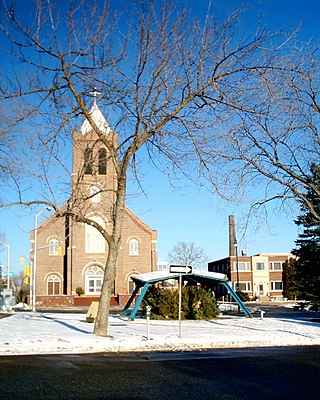
St. Andrew's Church is a Roman Catholic Parish church in Thunder Bay, Ontario. It was founded by the Society of Jesus in the 1872 and is a centre for ministry with the Fort William First Nation. It is situated on Connaught Square in the Port Arthur area of the city.
Villa Loyola is a centre in Ignatian spirituality run by the Society of Jesus in Greater Sudbury, Ontario, Canada. It is the only Canadian French-speaking Jesuit centre outside of Quebec. As well serving as a retreat centre it is also an ecumenical and interfaith conference centre. It is situated on the shore of Long Lake off Municipal Road 80 to the south of Sudbury's urban core.

St. Patrick's Cathedral or Thunder Bay Cathedral is the Roman Catholic cathedral for the Diocese of Thunder Bay. It is situated on the corner of Donald and Archibald Streets in the city.
St. Agnes Church is a Roman Catholic Parish church in Thunder Bay, Ontario. It was founded by the Society of Jesus in 1885. It is situated in the centre of the city on the corner of Mary Street West and Brown Street.
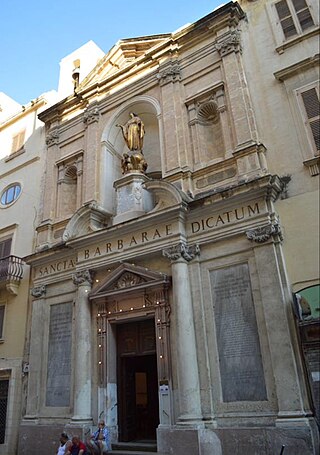
The Church of St Barbara is a Roman Catholic church situated in Valletta, Malta. The church was built to service the spiritual needs of the knights of Provence.
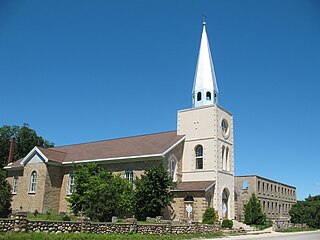
Holy Cross Church is a Roman Catholic Parish church in the Wiikwemkoong Unceded Reserve, north-eastern Manitoulin island. It was founded by the Society of Jesus (Jesuits) in 1844 and was their first mission in Northern Ontario since their suppression in 1767. The mission played a significant role in increasing literacy in Canada of the Ojibwe language. The church building itself was constructed in 1852. It is situated to the north of Wiikwemkoong on Wikwemikong Way, next to the Giizhigaanang Community Centre.


